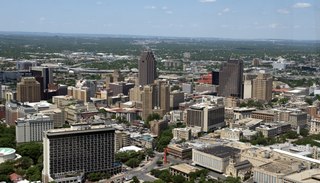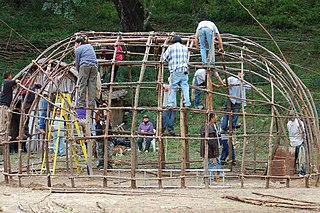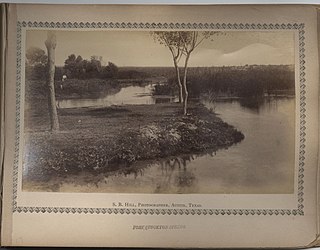
Val Verde County is a county located on the southern Edwards Plateau in the U.S. state of Texas. The 2020 population is 47,586. Its county seat is Del Rio. The Del Rio micropolitan statistical area includes all of Val Verde County.

Uvalde County is a county located in the U.S. state of Texas. As of the 2020 census, its population was 24,564. Its county seat is Uvalde. The county was created in 1850 and organized in 1856. It is named for Juan de Ugalde, the Spanish governor of Coahuila. Uvalde County was founded by Reading Wood Black, who also founded the city of Uvalde, Texas. Uvalde County comprises the Uvalde, TX Micropolitan Statistical Area.

Kinney County is a county located in the U.S. state of Texas. As of the 2020 census, its population was 3,129. Its county seat is Brackettville. The county was created in 1850 and later organized in 1874. It is named for Henry Lawrence Kinney, an early settler.

Hudspeth County is a county located in the U.S. state of Texas. As of the 2020 census, the population was 3,202. Its county seat is Sierra Blanca, and the largest community is Fort Hancock. The county is named for Claude Benton Hudspeth, a state senator and United States Representative from El Paso. It is northeast of the Mexico–U.S. border.

Brewster County is a county located in the U.S. state of Texas. It is in West Texas and its county seat is Alpine. It is one of the nine counties that comprise the Trans-Pecos region, and borders Mexico. Brewster County is the largest county by area in the state - at 6,192 square miles (16,040 km2) it is over three times the size of the state of Delaware, and more than 500 square miles (1,300 km2) bigger than Connecticut.

Coahuila, formally Coahuila de Zaragoza, officially the Free and Sovereign State of Coahuila de Zaragoza, is one of the 32 states of Mexico.

Piedras Negras is a city and seat of the surrounding municipality of the same name in the Mexican state of Coahuila. It stands at the northeastern edge of Coahuila on the Mexico–United States border, across the Rio Grande from Eagle Pass in the U.S. state of Texas. In the 2015 census the city had a population of 163,595 inhabitants, while the metropolitan area had a population of 245,155 inhabitants. The Piedras Negras and the Eagle Pass areas are connected by the Eagle Pass–Piedras Negras International Bridge, Camino Real International Bridge, and the Union Pacific International Railroad Bridge.

U.S. Highway 57 (US 57) is a 98-mile (158 km) north–south intrastate United States highway that follows a nearly east–west route in the southwestern part of the U.S. state of Texas. The highway's northern (eastern) terminus is about 50 miles (80 km) south of San Antonio, Texas, between Devine and Pearsall, at an intersection with Interstate 35. Its southern (western) terminus is in Eagle Pass, at the Rio Grande, where it continues into Piedras Negras, Coahuila, as Mexican Federal Highway 57.

South Texas is a region of the U.S. state of Texas that lies roughly south of—and includes—San Antonio. The southern and western boundary is the Rio Grande, and to the east it is the Gulf of Mexico. The population of this region is about 4.96 million according to the 2017 census estimates. The southern portion of this region is often referred to as the Rio Grande Valley. The eastern portion along the Gulf of Mexico is also referred to as the Coastal Bend.

Piedras Negras International Airport is an international airport located in Piedras Negras, Coahuila, Mexico, near the Mexico–United States border. It serves domestic flights within Mexico for the Eagle Pass-Piedras Negras binational metropolitan area, the northern Coahuila region and Southern Texas. It also supports cargo operations, as well as executive and general aviation activities. Passengers traveling to destinations in the United States typically utilize the larger San Antonio International Airport. Piedras Negras Airport is operated by Administradora Coahuilense de Infraestructura y Transporte Aéreo, a state-owned operator. It handled 24,170 passengers in 2019, and 9,481 passengers in 2020.

The Kickapoo Traditional Tribe of Texas, based in Eagle Pass, is a federally recognized tribe that uses revenue from its gaming and business operations to provide housing, education, and social services to its members. The tribe has been held as a model for other Native American tribes seeking to lift their members out of poverty, because they were living under the international bridge over the Rio Grande as recently as the 1980s.

Fort Duncan was a United States Army base, set up to protect the first U.S. settlement on the Rio Grande near the current town of Eagle Pass, Texas.
The Quems were an indigenous people who lived along the Rio Grande in what is now the U.S. state of Texas and the Mexican state of Coahuila in the 17th and 18th centuries. They are known to have settled around present-day Eagle Pass and Piedras Negras. Damián Massanet also recorded them, in 1691, as one of six groups of Indians encountered along a stream called "Caramanchel"; this appears to correspond with today's Comanche Creek in the southwestern part of Zavala County. Massenet implied that all six groups spoke a language now known as Coahuilteco.

Eagle Pass is a city in and the county seat of Maverick County in the U.S. state of Texas. Its population was 28,130 as of the 2020 census.

Guerrero is one of the 38 municipalities of Coahuila, in north-eastern Mexico. The municipal seat lies at Guerrero. The municipality covers an area of 3,219.7 km2 and is located on the international border between Mexico and the USA, here formed by the Río Bravo del Norte, adjacent to the U.S. state of Texas.

Jiménez is one of the 38 municipalities of Coahuila, in north-eastern Mexico. The municipal seat lies at Jiménez. The municipality covers an area of 3040.9 km2 and is located on the international border between Mexico and the USA, here formed by the Río Bravo del Norte, adjacent to the U.S. state of Texas.

Piedras Negras Municipality is one of the 38 municipalities of Coahuila, in north-eastern Mexico. The municipal seat lies at Piedras Negras. The municipality covers an area of 914.2 km2 and is located on the international border between Mexico and the USA, here formed by the Río Bravo del Norte, adjacent to the U.S. state of Texas.
Ludwig "Louis" Martin was with the first settlers to Fredericksburg, Texas. He was the first sheriff of Gillespie County, and also served as District Clerk of the county. Martin was a co-founder of the Mason County community of Hedwigs Hill.
Hedwigs Hill is an unincorporated farming and ranching community, established in 1853, just off U.S. Highway 87, located 5 miles (8.0 km) south of Art in southern Mason County, Texas, United States.

Comanche Springs was an aquifer of six artesian springs geographically located between the Edwards Plateau and the Trans-Pecos regions of West Texas. The military fortification Camp Stockton was built around the springs, eventually growing become the city of Fort Stockton.

























